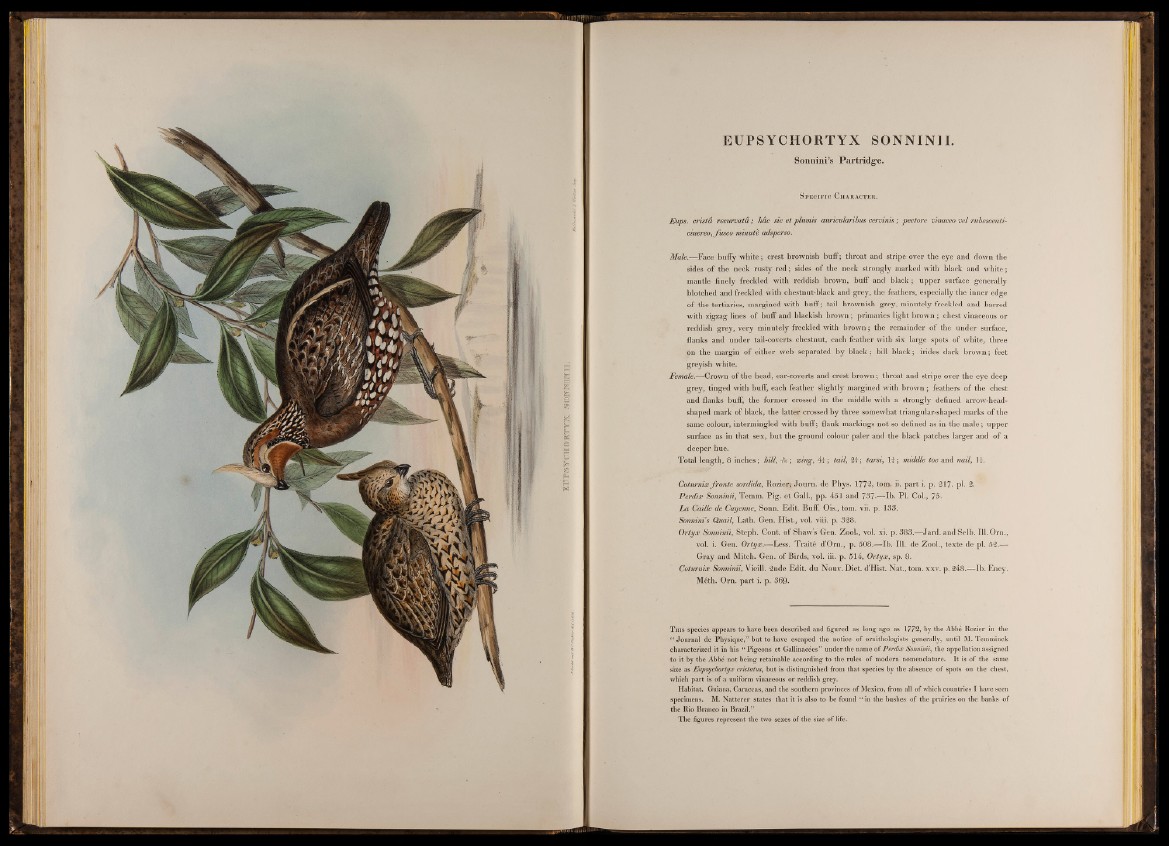
E1TFSYCH0RTYX §© 1 1 1 1 1 1 .
EUPSYCHORTYX SONNINII.
Sonnini’s Partridge.
S p e c if ic C h aracter.
Eups. crista recurvata ; hâc sic et plumis auricularibus ceroinis ; pectore vinaceo vel rubescenti-
cinereo,Jusco minute adsperso.
Male.—Face buffy white ; crest brownish buff ; throat and stripe over the eye and down the
sides o f the neck rusty red ; sides o f the neck strongly marked with black and white ;
mantle finely freckled with reddish brown, buff and black ; upper surface generally
blotched and freckled with chestnut-black and grey, the feathers, especially the inner edge
o f the tertiaries, margined with buff ; tail brownish grey, minutely freckled and barred
with zigzag lines o f buff and blackish brown ; primaries light brown ; chest vinaceous or
reddish grey, very minutely freckled with brown ; the remainder o f the under surface,
flanks and under tail-coverts chestnut, each feather with six large spots o f white, three
on the margin o f either web separated by black ; bill black ; irides dark brown ; feet
greyish white.
Female.—Crown o f the head, ear-coverts and crest brown ; throat and stripe over the eye deep
grey, tinged with buff, each feather slightly margined with brown ; feathers o f the chest
and flanks buff, the former crossed in the middle with a strongly defined arrow-headshaped
mark o f black, the latter crossed by three somewhat triangular-shaped marks o f the
same colour, intermingled with buff; flank markings not so defined as in the male; upper
surface as in that sex, but the ground colour paler and the black patches larger and o f a
deeper hue.
Total length, 8 inches; bill, tV; wing, 4 f ; tail, 2£; tarsi, I t ; middle toe and nail, I t .
Coturnix fr o u te sordida, Rozier; Journ. de Phys. 1779, tom- ii- part i. p. 217- pi. 2.
P e rd ix Sonninii, Temm. Pig. et Gall., pp. 451 and 737-—lb . PI. Col., 75.
L a Caille de Cayenne, Sonn. Edit. Buff. Ois., tom. vii. p. 133.
S o nninis Quail, Lath. Gen. Hist., vol. viii. p. 328.
O r ty x Sonninii, Steph. Cont. of Shaw’s Gen. Zool., vol. xi. p. 383.—Jard. and Selb. 111. Orn.,
vol. i. Gen. Ortyx.—Less. Traité d’Orn., p. 508.— lb. 111. de Zool., texte de pl. 52.—
Gray and Mitch. Gen. o f Birds, vol. iii. p. 514, Ortyx, sp. 8.
Coturnix Sonninii, Vieill. 2nde Edit, du Nouv. Diet. d’Hist. Nat., tom. xxv. p. 248.—lb . Ency.
Méth. Orn. part. i. p. 369-
T his species appears to have been described and figured as long ago as 1772, by the Abbé Rozier in the
“ Journal de Physique,” but to have escaped the notice of ornithologists generally, until M. Temminck
characterized it in his “ Pigeons et Gallinacées” under the name of Perdix Sonninii, the appellation assigned
to it by the Abbé not being retainable according to the rules of modern nomenclature. It is of the same
size as Eupsychortyx cristalus, but is distinguished from that species by the absence of spots on the chest,
which part is of a uniform vinaceous or reddish grey.
Habitat. Guiana, Caraccas, and the southern provinces of Mexico, from all of which countries I have seen
specimens. M. Natterer states that it is also to be found “ in the bushes of the prairies on the banks of
the Rio Branco in Brazil.”
The figures represent the two sexes of the size of life.